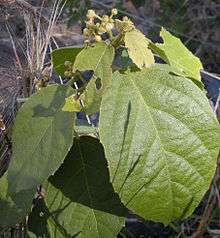Grewia latifolia
| Grewia latifolia | |
|---|---|
 | |
| Dogs Balls (Grewia latifolia) | |
| Scientific classification | |
| Kingdom: | Plantae |
| (unranked): | Angiosperms |
| (unranked): | Eudicots |
| (unranked): | Rosids |
| Order: | Malvales |
| Family: | Malvaceae |
| Subfamily: | Grewioideae |
| Tribe: | Grewieae |
| Genus: | Grewia |
| Species: | G. latifolia |
| Binomial name | |
| Grewia latifolia F.Muell. ex Benth. | |
| Synonyms | |
| |
Grewia latifolia is a small shrub endemic to Northern and Eastern Australia. Growing to a height of 2m, the species is characterised by ovate leaves with serrated margins. The leaves are discolourous with green papery upper surfaces and pale green to yellow pubescent lower surfaces. The species is deciduous, shedding leaves in response to dry conditions. Cream coloured flowers are produced year round. Fruits are woody capsules with four externally visible compartments covered with coarse hairs. These fruits have a distinct similarity to dog testicles, giving rise to the common name of Dogs Balls.[2] Other common names include Emu Berry and Dysentery Bush.
Ecology and uses
G. latifolia grows in open woodland on free draining soils. It is highly drought tolerant and shoots from underground roots and stems when defoliated by fire or grazing.
Fruit of G. latifolia are edible, with a thin layer of sweet flesh covering the woody inner capsules and were a minor food source for Australian Aborigines. The fruit were also used by both Aborigines and early Europeans as a treatment for diarrhea, hence the common name of Dysentery Bush.
Notes
- ↑ http://www.theplantlist.org/tpl/record/kew-2833171
- ↑ Quattrocchi, Umberto (1999), CRC World Dictionary of Plant Names: Common Names, Scientific Names, Eponyms, Synonyms, and Etymology, Volume 2 CRC World Dictionary of Plant Names: Common Names, Scientific Names, Eponyms, Synonyms, and Etymology, Taylor & Francis US, ISBN 9780849326769